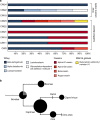Ancient proteins from ceramic vessels at Çatalhöyük West reveal the hidden cuisine of early farmers
- PMID: 30283003
- PMCID: PMC6170438
- DOI: 10.1038/s41467-018-06335-6
Ancient proteins from ceramic vessels at Çatalhöyük West reveal the hidden cuisine of early farmers
Abstract
The analysis of lipids (fats, oils and waxes) absorbed within archaeological pottery has revolutionized the study of past diets and culinary practices. However, this technique can lack taxonomic and tissue specificity and is often unable to disentangle signatures resulting from the mixing of different food products. Here, we extract ancient proteins from ceramic vessels from the West Mound of the key early farming site of Çatalhöyük in Anatolia, revealing that this community processed mixes of cereals, pulses, dairy and meat products, and that particular vessels may have been reserved for specialized foods (e.g., cow milk and milk whey). Moreover, we demonstrate that dietary proteins can persist on archaeological artefacts for at least 8000 years, and that this approach can reveal past culinary practices with more taxonomic and tissue-specific clarity than has been possible with previous biomolecular techniques.
Conflict of interest statement
The authors declare no competing interests.
Figures





References
Publication types
MeSH terms
Substances
LinkOut - more resources
Full Text Sources
Molecular Biology Databases
Miscellaneous

